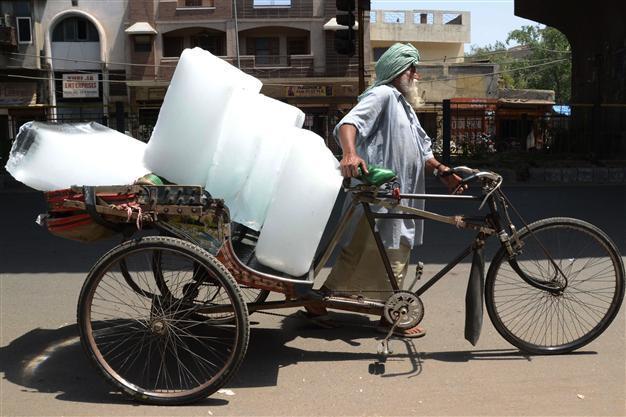Hospitals overwhelmed as India heat wave deaths near 1,500
NEW DELHI – Agence France-Presse

An Indian worker uses a ricksahw to transport ice from an ice factory in Amritsar on May 27, 2015. More than 1,100 people have died in a blistering heatwave sweeping India, authorities said May 27, 2015, as forecasters warned searing temperatures would continue. AFP Photo
Hospitals in India were struggling on May 28 to cope with an influx of victims of a blistering heat wave that has claimed nearly 1,500 lives in just over a week.
Hundreds of people - mainly from the poorest sections of society - die at the height of summer every year in India, but this year’s figures are unusually high.
In southern Andhra Pradesh - by far the worst-hit state - 1,020 people have died since May 18, more than double the number of heat-related deaths for the whole of last year.
In neighboring Telangana, where temperatures hit 48 degrees Celsius over the weekend, 340 people have died from the heat recently compared to 31 in the whole of last year.
“Heat wave conditions in 2015 so far have been of a shorter duration, yet with a higher death toll,” said Arjuna Srinidhi, program manager for climate change at the Centre for Science and Environment (CSE) research group.
“This could be due to the sudden change in temperatures after a prolonged wet February and March that had kept the temperatures cool.”
Hospitals in New Delhi, where top temperatures have soared to 45 degrees Celsius, were struggling to cope with the fall-out.
“Hospitals are overflowing with heatstroke victims,” said Ajay Lekhi, president of the Delhi Medical Association.
“Patients are complaining of severe headache and dizziness. They are also showing symptoms of delirium,” he added, describing a common symptom of severe dehydration.
The surge in demand for electricity from air conditioners led to power cuts in parts of Delhi, exacerbating the misery for residents of the capital.
Large queues formed outside the All India Institute of Medical Sciences, one of Delhi’s largest government-run hospitals, where women clutched plastic water bottles and packets of mango juice.
Others tried to console crying babies, their heads wrapped in handkerchiefs against the blistering sun.
“Last night there was no electricity for nearly five hours,” 31-year-old housewife Seema Sharma told AFP outside the hospital as she waited in line for her four-year-old son to be seen.
“You can imagine what we must have gone through. He just couldn’t sleep and kept on crying. Now he has fever as well,” she said.
Unconfirmed reports said two people had died in Delhi, where tens of thousands sleep on the streets with little protection from the heat.
State authorities have ordered that air coolers be installed in shelters for homeless people, which are often windowless tin shacks.
Most are equipped only with small fans, meaning temperatures inside the shelters are often considerably higher than outdoors.
“When the temperature soars it becomes difficult to sleep inside the tin cabin,” 54-year-old Delhi construction worker told the Hindustan Times daily.
“Sleeping on the road is a much better option.”
Forecasters said there was little hope of any immediate respite from the soaring temperatures in northern India, which have been aggravated by hot, dry winds.
“We think that these heat wave conditions will take another four to five days to subside,” said Brahma Prakash Yadav, director of the Indian Meteorological Department.
The Press Trust of India news agency reported 43 deaths from the heat wave in the eastern state of Orissa.
Another 13 succumbed to the heat in neighbouring West Bengal, where unions urged taxi drivers to stay off the roads during the day.
Two people died in western Maharashtra state, where authorities said they did not expect conditions to improve until the arrival of monsoon rains in June.
The monsoon is forecast to hit the southern state of Kerala towards the end of this month before sweeping across the country, but it will be weeks before the rains reach the arid plains.
